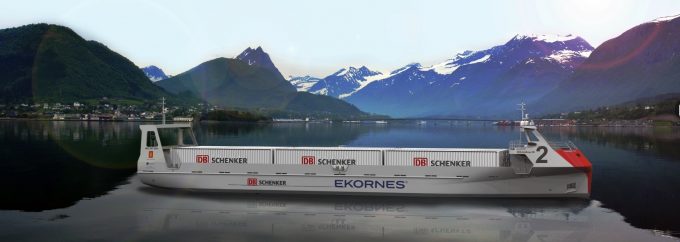How crazy is this: DSV goes hostile on Expeditors or CH Robinson?
Flying low, way too low…

DB Schenker has laid out plans to operate a zero-emission autonomous feeder vessel, which will deliver containers of furniture by Norwegian designer Ekornes, from the port of Ikornnes to the port of Ålesund for export.
Built by Naval Dynamics to its AutoBarge 250 Coast Feeder design, the vessel will carry up to 300dwt, some 43km between the ports, sailing at a speed of 7.7 knots. Tech company Kongsberg will produce the automated systems.
As The Loadstar has previously reported, battery-electric operation and reduced or eliminated crewing are coming to be regarded as intertwined concepts, thanks to the simplicity of the drivetrains, which have moving parts in the single digits in some cases.
These are likely to require far less maintenance, and therefore, crew members. “The navigational element doesn’t change, but in terms of the chief engineer, that part changes,” Kongsberg sales director Lars Kristien Moen told The Loadstar.
“We believe that the battery-electric propulsion will mean less problems – less maintenance, less caretaking on board, less operational workload.”
Regardless of the initial level of automation, the vessel will be remotely monitored by staff at Massterly’s Remote Operation Center (ROC), who will have secondary control authority. However, Kongsberg said it is not yet certain whether the 50m vessel will begin operation with a small crew, as has the larger Yara Birkeland, or begin operation without crew.
“At the moment the design is made without the bridge and wheelhouse, but we will spend the three months in the pre-study to elaborate internally what is viable,” said Mr Moen. “We cannot yet say for sure if it will start the operation unmanned, autonomous, or with a reduced crew.”
Mr Moen added the vessel would leverage Kongsberg’s research on automated crossing and docking, currently in use on ferries. “It is currently in commercial operation,” he said. “I think there have been 800 automated dockings now without any damages.”
Like Yara Birkeland, the vessel will benefit from Norway’s abundant supply of renewable hydropower, which allows the country to boast more than 90% renewable grid energy. Mr Moen explained that there was certainly interest in battery technology for ships in other parts of the world, but it remains to be seen whether the economics will make it worthwhile.
“We see this in the United States especially California, which has a reputation for being a bit more green than the other states. There are also signs that South Korea is going in this direction.”
Comment on this article